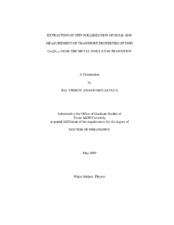| dc.contributor.advisor | Teizer, Winfried | |
| dc.creator | Srivastava, Raj Vibhuti A. | |
| dc.date.accessioned | 2010-07-15T00:14:09Z | |
| dc.date.accessioned | 2010-07-23T21:45:36Z | |
| dc.date.available | 2010-07-15T00:14:09Z | |
| dc.date.available | 2010-07-23T21:45:36Z | |
| dc.date.created | 2009-05 | |
| dc.date.issued | 2010-07-14 | |
| dc.date.submitted | May 2009 | |
| dc.identifier.uri | https://hdl.handle.net/1969.1/ETD-TAMU-2009-05-792 | |
| dc.description.abstract | Since the early 1960s, Abrikosov-Gorkov theory has been used to describe superconductors with paramagnetic impurities. Interestingly, the density of states resulting from the theoretical framework has to date only been known approximately, as a numeric solution of a complex polynomial. An analytical solution to the theory was discovered and applied to extract the spin polarization from the tunneling conductance of superconducting aluminium with 3-dimensional (3-D) amorphous (a-) gadoliniumxsilicon1-x (GdxSi1-x) as a counter electrode (Al/Al2O3/a-GdxSi1-x planar tunnel junction measured at T = 25 mK and H less than or equal to 3.0 T) in the quantum critical regime (QCR). The analytical solution is valid in the whole regime of Abrikosov-Gorkov theory independent of the presence of an energy gap.
Applying the spin polarized Abrikosov-Gorkov theory to describe aluminium gives a larger spin polarization in GdxSi1-x than the spin polarized Bardeen-Cooper-Schrieffer (BCS) theory. The purpose of this study is to extract polarization at various applied magnetic fields, but no specific relationship between the two could be determined. Results obtained shows a transition from a superconductor with a gap to a gapless superconductor in varying external magnetic fields was observed. To improve understanding of GdxSi1-x near the metal-insulator transition (MIT) and compare it with prior work, the initial experimental attempts to investigate the transport property of GdxSi1-x near the MIT in the 2-dimensional limit are presented. A low temperature ultra high vacuum quench condensation system was used to make thin films of GdxSi1-x and in-situ measurements were performed. The transport properties for different values of x and thicknesses were measured for T = 4.2 K to ~10 K. In addition to other possible causes, the uncertainty in the electron impact emission spectroscopy (EIES) appeared to be a major reason behind the observed error in x when gadolinium and silicon are co-evaporated. The problems faced during the co-evaporation are also discussed. | en |
| dc.format.mimetype | application/pdf | |
| dc.language.iso | eng | |
| dc.subject | amorphous thin films | en |
| dc.subject | tunneling conductance | en |
| dc.subject | (gapless) superconductivity | en |
| dc.subject | Abrikosov Gorkov theory | en |
| dc.title | Extraction of Spin Polarization of Bulk and Measurement of Transport Properties of Thin GdxSi1-x Near the Metal-Insulator Transition | en |
| dc.type | Book | en |
| dc.type | Thesis | en |
| thesis.degree.department | Physics | en |
| thesis.degree.discipline | Physics | en |
| thesis.degree.grantor | Texas A&M University | en |
| thesis.degree.name | Doctor of Philosophy | en |
| thesis.degree.level | Doctoral | en |
| dc.contributor.committeeMember | Agnolet, Glen | |
| dc.contributor.committeeMember | Naugle, Don | |
| dc.contributor.committeeMember | Cheng, Mosong | |
| dc.type.genre | Electronic Dissertation | en |
| dc.type.material | text | en |


